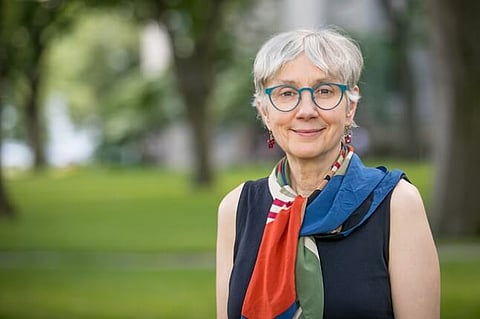‘We don’t fully understand what governs India’s temperature trends’
India faces a double-edged environmental crisis: Efforts to reduce aerosol air pollution — tiny particles in the air from industrial emissions, burning fossil fuels and biomass — may accelerate atmospheric warming, leading to more frequent and intense heatwaves. This raises the risk of hotter summers and more frequent and intense heatwaves in the coming decades.
The country has warmed about half as much as other regions in the northern hemisphere, using 1951-1980 as the baseline, according to data from the United States’ National Aeronautics and Space Administration. While the precise reasons for this anomaly remain underexplored, contributing factors could include high aerosol loads and extensive irrigation, both of which suppress local temperature increases.
Down To Earth spoke with Loretta J Mickley, senior research fellow and co-lead of Atmospheric Chemistry Modeling Group at Harvard, about aerosols, their impact on India’s surface temperatures and uncertainty in climate projections for the country.
Akshit Sangomla (AS): Were you surprised by the fact that India has warmed only half as much as the rest of the Northern Hemisphere since 1950?
Loretta J. Mickley (LJM): I am curious about the statement that India has warmed only half as much as the rest of the Northern Hemisphere. Much of the warming has occurred over higher latitudes such as Siberia and Alaska due to the ice-albedo feedback. I would be interested in comparing India’s warming rate with other regions at similar latitudes, such as Mexico. I need to look into this in more detail.
AS: What could be the reasons for slower warming over India? What are the major factors involved?
LJM: There could be several reasons India has not warmed as swiftly. A major one that comes to mind is the effect of aerosols or particulate matter — really tiny particles suspended in the air. These particles interact with sunlight and clouds: They can reflect sunlight like tiny mirrors or absorb it. Reflective aerosols, which are lighter in colour, tend to be made of sulphates from power plants. The absorbing ones, like black carbon or soot, are darker.
In general, both scattering and absorption reduce the amount of sunlight reaching the Earth’s surface, making it cooler. I want to emphasise that this is the case generally. Reflection means the sunlight is lost as if it never existed, whereas absorption means that a specific layer of the atmosphere warms while remaining cooler beneath.
India is a special case. Studies have tried to understand this complex interaction of aerosols over India, where both reflective and absorbing aerosols coexist. In the eastern United States, we historically had mostly reflective sulphates. But in India, there is a significant amount of black carbon due to industrial activities and crop burning, which makes Indian aerosols more absorbing.
These aerosols also interact with clouds along with interactions with sunlight, adding complexity. Generally, aerosols can increase cloud cover, but in some situations, they can reduce it.
The cooler temperatures in India might be linked to aerosols. However, some studies offer counterpoints. For instance, a 2021 study published in the journal Environmental Research by scientists from India’s Central University of Jharkhand and the US’ University of Southampton found that particulate matter levels over Delhi fell by 25 per cent during the first COVID-19 lockdown (March-May 2020). That was expected. But unexpectedly, land surface temperatures at night also declined by 2-4°C.
One explanation offered by the study’s authors was that black carbon aerosols are not very high in the atmosphere. When near the surface, these particles absorb sunlight and heat the surface air. If the black carbon had been higher in the atmosphere, the warming would have occurred aloft, possibly cooling the surface. So, removing black carbon during the lockdown may have actually led to surface cooling.
There may also have been other weather-related feedbacks involving cloud formation. This study relied on observational data rather than computer models that can carry various biases and uncertainties. In my view, it shows how little we still understand about the temperature dynamics in India. That’s why, to answer your original question, the short answer is: I don’t know.
AS: Why is there so much uncertainty around current and projected temperatures over India?
LJM: There are two main reasons for this uncertainty. First, we don’t have precise knowledge of the mix of aerosols—how much is absorbing and how much is reflective? While we do have surface-level measurements of particulate matter, we lack detailed information on aerosol composition, particularly sulphates versus black carbon. This makes it very difficult to project how India’s temperatures will evolve.
The second issue is how aerosols or particulate matter interact with clouds, especially during the monsoon. This interaction is also hard to understand. A 2021 paper in the journal Climate Dynamics suggested that removing black carbon aerosols could lead to stronger winds and increased moisture during monsoons. Aerosols can act as cloud condensation nuclei, encouraging cloud formation. But black carbon can also absorb sunlight and warm the air around it, causing water vapour to evaporate—resulting in fewer clouds.
The drivers of rain in India are so different from the drivers of rain in New York City. All these factors make both current understanding and future projections for India’s climate quite uncertain.
AS: How do you think India’s climate will evolve in the future, and what role will aerosols play?
LJM: Because of the challenges I’ve mentioned, I can’t say for sure how India’s climate will change. But aerosols will certainly play a major role. There’s still a lot to learn. I hope India manages to reduce pollution in the future—it’s quite severe, especially in the Indo-Gangetic Plain, and it’s shortening lives, particularly for children and the elderly. Cutting emissions through something like a clean air Act would be a good step, though enforcing it would be a challenge.

